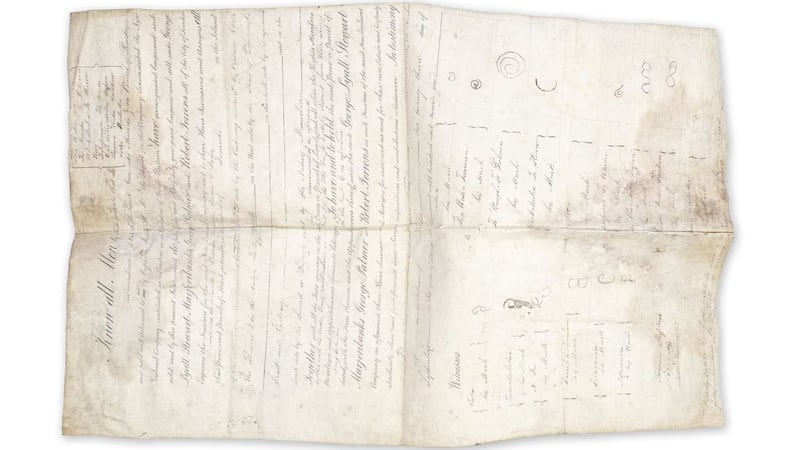A historic land deed showing Britain’s first attempt to colonise New Zealand, with islands in the Hauraki Gulf being bought from Māori for “one double barrel gun, eight muskets and one barrel of powder”, has sold at auction for more than $100,000.
The tattered, water-stained 198-year-old document, signed by eight Māori chiefs using their moko, or mark, outstripped an uncorrected proof copy of Harry Potter and the Philosopher’s Stone signed by author JK Rowling to fetch £53,740 at Bonhams auction house in London Wednesday night (NZ time).
Bonhams are tight-lipped over who bought the rare artefact that predates the Treaty of Waitangi by almost 14 years, citing “client confidentiality”.
The land deed, which was signed on September 23, 1826, represents the earliest organised attempt at the colonisation of Aotearoa.
The agreement between local chiefs and officials from the first New Zealand Company, who arrived on the settler ship Rosanna, exchanged guns and powder for various parcels of land “in the district of Tamaki” and included Pakatoa, Rotoroa, Ponui and Pakihi islands “bounded in the west side by the eastuary [sic] named by Captain Cook The Thames and by the natives Te Cuppa”.

It included “all the trees growing” on the islands, as well as the creeks, bays, harbours and the sea for three miles “distant from their shores”.
Thomas Kendall, one of New Zealand’s first Christian missionaries, whose career ended in disgrace, attests at the foot of the document how he has translated the deal to the chiefs and that they “fully understand the ... meaning of the contents”.
However, historian Vincent O’Malley, author of The Great War for New Zealand, earlier raised doubts over the claims.
“In the 1820s, the prospects that Māori might have understood that transaction in the same way that Europeans would, would be virtually nil,” he told the Herald.
“Māori had no conception of land sales. It wasn’t part of tikanga – a land sale was a completely foreign concept.”
A simple line map drawn on the back of the document shows the rough area involved in the sale, bordering “Wyheckee”, now Waiheke Island.
The document surfaced through the family of shipowner and merchant George Lyall (1779-1853), a trustee of the first New Zealand Company, which had limited success until merging with Edward Gibbon Wakefield’s New Zealand Association.
O’Malley said the first New Zealand Company’s efforts to buy Māori land were largely unsuccessful, despite offering highly sought-after goods.
“This transaction is taking place at the height of the Musket Wars, so every iwi is wanting access to firearms and ammunition and so on.
“It wasn’t uncommon for muskets to form part of the payment price for land at this time. There would be a range of goods – tobacco, blankets, all sorts of goods usually imported from Sydney.”
According to Auckland Council, the islands are part of the rohe (territory) of the Hauraki iwi, including Ngāi Tai, Ngāti Pāoa, Ngāti Whanaunga, Ngāti Tamaterā, Ngāti Te Ata and Ngāti Maru. The Hauraki Māori Trust Board, which represents these iwi, declined to comment on the sale.
A photographic reproduction of the original deed is held at the Auckland Public Library. It was understood that there were no other copies of the transaction but the Herald has been told there is one held at Archives New Zealand in Wellington.
The Ministry of Culture and Heritage monitors auctions within New Zealand but does not follow those held overseas.
It has no ability under legislation such as the Protected Objects Act 1975 to stop sales or force repatriation of material sold overseas.


